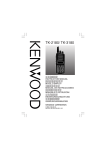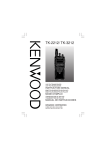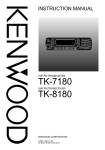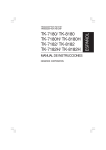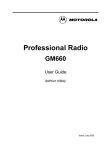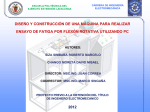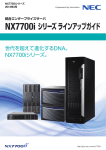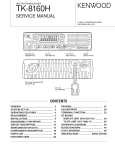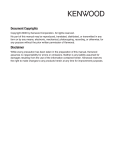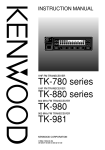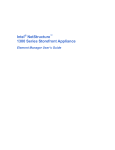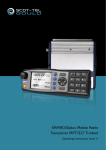Download Kenwood TK-7160 Car Stereo System User Manual
Transcript
TK-7160/ TK-8160
TK-7160H/ TK-8160H
VHF FM TRANSCEIVER/ UHF FM TRANSCEIVER
INSTRUCTION MANUAL
ÉMETTEUR-RÉCEPTEUR FM VHF/ ÉMETTEUR-RÉCEPTEUR FM UHF
MODE D’EMPLOI
TRANSCEPTOR FM VHF/ TRANSCEPTOR FM UHF
MANUAL DE INSTRUCCIONES
© B62-1829-10 (K, M)
09 08 07 06 05 04 03 02 01
TK-7160/ TK-8160
TK-7160H/ TK-8160H
INSTRUCTION MANUAL
ENGLISH
VHF FM TRANSCEIVER/
UHF FM TRANSCEIVER
THANK YOU
We are grateful you chose KENWOOD for your personal mobile applications.
We believe this easy-to-use transceiver will provide dependable communications
to keep personnel operating at peak efficiency.
KENWOOD transceivers incorporate the latest in advanced technology. As a
result, we feel strongly that you will be pleased with the quality and features of
this product.
MODELS COVERED BY THIS MANUAL
The models listed below are covered by this manual:
• TK-7160: VHF FM Transceiver
• TK-7160H: VHF FM Transceiver
• TK-8160: UHF FM Transceiver
• TK-8160H: UHF FM Transceiver
NOTICES TO THE USER
◆ Government law prohibits the operation of unlicensed transmitters within the territories under
government control.
◆ Illegal operation is punishable by fine and/or imprisonment.
◆ Refer service to qualified technicians only.
SAFETY: It is important that the operator is aware of, and understands, hazards
common to the operation of any transceiver.
◆ EXPLOSIVE ATMOSPHERES (GASES, DUST, FUMES, etc.)
Turn OFF your transceiver while taking on fuel or while parked in gasoline service stations. Do not
carry spare fuel containers in the trunk of your vehicle if your transceiver is mounted in the trunk area.
◆ INJURY FROM RADIO FREQUENCY TRANSMISSIONS
Do not operate your transceiver when somebody is either touching the antenna or standing within
2 to 3 feet (60 to 90 cm) of it, to avoid the possibility of radio frequency burns or related physical
injury.
◆ DYNAMITE BLASTING CAPS
Operating the transceiver within 500 feet (150 m) of dynamite blasting caps may cause them to
explode. Turn OFF your transceiver when in an area where blasting is in progress, or where
“TURN OFF TWO-WAY RADIO” signs have been posted. If you are transporting blasting caps in
your vehicle, make sure they are carried in a closed metal box with a padded interior. Do not
transmit while the caps are being placed into or removed from the container.
i
PRECAUTIONS
Observe the following precautions to prevent fire, personal injury, and transceiver
damage.
• Do not attempt to configure the transceiver while driving; it is too dangerous.
• Do not disassemble or modify the transceiver for any reason.
• Do not expose the transceiver to long periods of direct sunlight, nor place it near
heating appliances.
• Do not place the transceiver in excessively dusty, humid, or wet areas, nor on unstable
surfaces.
• If an abnormal odor or smoke is detected coming from the transceiver, switch the
transceiver power off immediately, and contact your KENWOOD dealer.
• Use of the transceiver while you are driving may be against traffic laws. Please check
and observe the vehicle regulations in your area.
• Do not use options not specified by KENWOOD.
One or more of the following statements may be applicable:
FCC WARNING
This equipment generates or uses radio frequency energy. Changes or modifications to this equipment may cause
harmful interference unless the modifications are expressly approved in the instruction manual. The user could
lose the authority to operate this equipment if an unauthorized change or modification is made.
INFORMATION TO THE DIGITAL DEVICE USER REQUIRED BY THE FCC
This equipment has been tested and found to comply with the limits for a Class B digital device, pursuant to Part 15
of the FCC Rules. These limits are designed to provide reasonable protection against harmful interference in a
residential installation.
This equipment generates, uses and can generate radio frequency energy and, if not installed and used in
accordance with the instructions, may cause harmful interference to radio communications. However, there is no
guarantee that the interference will not occur in a particular installation. If this equipment does cause harmful
interference to radio or television reception, which can be determined by turning the equipment off and on, the user is
encouraged to try to correct the interference by one or more of the following measures:
•
Reorient or relocate the receiving antenna.
•
Increase the separation between the equipment and receiver.
•
Connect the equipment to an outlet on a circuit different from that to which the receiver is connected.
•
Consult the dealer for technical assistance.
ii
CONTENTS
UNPACKING AND CHECKING EQUIPMENT ................................... 1
SUPPLIED ACCESSORIES ..................................................................... 1
PREPARATION .................................................................................. 2
TOOLS REQUIRED .............................................................................. 2
POWER CABLE CONNECTION ............................................................... 2
INSTALLING THE TRANSCEIVER .............................................................. 3
CONNECTING A MICROPHONE ............................................................... 4
GETTING ACQUAINTED ................................................................... 5
FRONT PANEL ................................................................................... 5
DISPLAY ........................................................................................... 7
REAR PANEL ..................................................................................... 7
PROGRAMMABLE FUNCTIONS ...................................................... 8
BASIC OPERATIONS ...................................................................... 10
SWITCHING POWER ON/ OFF ........................................................... 10
ADJUSTING THE VOLUME ................................................................... 10
SELECTING A ZONE AND CHANNEL ...................................................... 11
TRANSMITTING ................................................................................. 11
RECEIVING ...................................................................................... 11
SCAN ................................................................................................ 12
PRIORITY SCAN ............................................................................... 12
ADD TO SCAN/ DELETE FROM SCAN ................................................... 13
REVERT CHANNEL ............................................................................ 13
DTMF CALLS ................................................................................... 14
STORE & SEND ............................................................................... 14
MANUAL DIALING ............................................................................. 14
STORING DTMF NUMBERS ............................................................... 14
DIALING STORED DTMF NUMBERS .................................................... 15
CLEARING STORED DTMF NUMBERS ................................................. 15
REDIALING ...................................................................................... 15
STUN ............................................................................................. 15
QUIET TALK (QT)/ DIGITAL QUIET TALK (DQT) .......................... 16
OPERATOR SELECTABLE TONE (OST) ................................................ 16
iii
CODE SQUELCH (ID CODE) ..........................................................
RECEIVING ......................................................................................
TRANSMITTING .................................................................................
SELECTIVE CALL ...........................................................................
RECEIVING ......................................................................................
TRANSMITTING .................................................................................
2-TONE SIGNALING ........................................................................
RECEIVING ......................................................................................
TRANSMITTING .................................................................................
FleetSync: ALPHANUMERIC 2-WAY PAGING SYSTEM ..............
GPS REPORT .................................................................................
SELCALL (SELECTIVE CALLING) .........................................................
STATUS MESSAGE ............................................................................
EMERGENCY OPERATION .............................................................
ADVANCED OPERATIONS .............................................................
TALK-AROUND ................................................................................
DTMF NUMBER DISPLAY .................................................................
HORN ALERT ...................................................................................
PUBLIC ADDRESS (PA) SYSTEM ........................................................
MONITOR ........................................................................................
SQUELCH LEVEL ..............................................................................
VOICE SCRAMBLER ..........................................................................
KEY LOCK ......................................................................................
BACKGROUND OPERATIONS .......................................................
TIME-OUT TIMER (TOT) ...................................................................
BUSY CHANNEL LOCKOUT (BCL) ......................................................
BEGINNING/ END OF TRANSMIT SIGNAL ...............................................
iv
17
17
17
18
18
18
19
19
19
20
20
20
21
22
23
23
23
23
24
24
24
25
25
26
26
26
26
UNPACKING AND CHECKING EQUIPMENT
Note: The following unpacking instructions are for use by your KENWOOD dealer, an authorized
KENWOOD service facility, or the factory.
Carefully unpack the transceiver. We recommend that you identify the items
listed in the following table before discarding the packing material. If any items
are missing or have been damaged during shipment, file a claim with the carrier
immediately.
SUPPLIED ACCESSORIES
Item
Microphone (with cable)
(K type only)
Microphone hanger (with 4 x 16 mm self-tapping
screws) (K type only)
DC power cable (with fuses)
• 10 A fuse (TK-7160/ TK-8160 only)
• 15 A fuse (TK-7160H/ TK-8160H only)
Mounting bracket
Screw set:
• 5 x 16 mm self-tapping screw (4 pieces)
• Hex-headed screw with washer (4 pieces)
• Spring washer (4 pieces)
• Flat washer (4 pieces)
Instruction manual
Microphone (with cable)
DC power cable (with fuses)
Part Number
Quantity
T91-0639-XX
1
J19-1584-XX
1
E30-3339-XX
F51-0016-XX
F51-0017-XX
J29-0662-XX
1
1
N99-0395-XX
1
B62-1829-XX
1
2
Microphone hanger
(with 4 x 16 mm self-tapping screws)
Mounting bracket
Screw set
1
PREPARATION
Various electronic equipment in your vehicle may malfunction if they are not properly protected from
the radio frequency energy which is present while transmitting. Electronic fuel injection, anti-skid
braking, and cruise control systems are typical examples of equipment that may malfunction. If your
vehicle contains such equipment, consult the dealer for the make of vehicle and enlist his/her aid in
determining if they will perform normally while transmitting.
Note: The following preparation instructions are for use by your KENWOOD dealer, an authorized
KENWOOD service facility, or the factory.
TOOLS REQUIRED
Note: Before installing the transceiver, always check how far the mounting screws will extend below
the mounting surface. When drilling mounting holes, be careful not to damage vehicle wiring or parts.
The following tools are required for installing the transceiver:
• 6 mm (1/4 inch) or larger electric drill
• 4.2 mm (5/32 inch) drill bit for the 5 x 16 mm self-tapping screws
• 3.2 mm (1/8 inch) drill bit for the 4 x 16 mm self-tapping screws
• Circle cutters
POWER CABLE CONNECTION
The transceiver operates in 12 V negative ground systems only! Check the battery polarity and
voltage of the vehicle before installing the transceiver.
1 Check for an existing hole, conveniently located in the firewall, where the
power cable can be passed through.
• If no hole exists, use a circle cutter to drill the firewall, then install a rubber
grommet.
2 Run the two power cable leads through the firewall and into the engine
compartment, from the passenger compartment.
3 Connect the red lead to the positive (+) battery terminal and the black lead to
the negative (–) battery terminal.
• Locate the fuse as close to the battery as possible.
4 Coil the surplus cable and secure with a retaining band.
• Be sure to leave enough slack in the cables so the transceiver can be removed for
servicing while keeping the power applied.
2
INSTALLING THE TRANSCEIVER
For passenger safety, install the transceiver securely using the supplied mounting bracket, so the
transceiver will not break loose in the event of a collision.
1 Mark the position of the holes in the dash by using the mounting bracket as a
template. Drill the holes, then attach the mounting bracket using the supplied
5 x 16 mm self-tapping screws.
• Be sure to mount the transceiver in a location where the controls are within easy
reach of the user and where there is sufficient space at the rear of the transceiver
for cable connections.
2 Connect the antenna and the supplied power cable to the transceiver.
3 Slide the transceiver into the mounting bracket and secure it using the
supplied hex-headed screws.
4 Mount the microphone hanger in a location where it will be within easy reach
of the user.
• The microphone and microphone cable should be mounted in a place where they
will not interfere with the safe operation of the vehicle.
When replacing the fuse in the DC power cable, be sure to replace it with a fuse of the same value.
Never replace a fuse with one that is rated with a higher value.
Flat washer
Hex-headed screw
Spring
washer
Microphone
5 x 16 mm self-tapping screw
Antenna
connector
Mounting bracket
Power input
connector
Black (–) cable
Red (+) cable
DC power cable
Fuse
12 V
vehicle
battery
Note: The microphone is supplied only with K type models; it is not supplied with M type models.
The model type is marked on the carton.
3
CONNECTING A MICROPHONE
1 Insert the microphone plug into the jack on
the front panel of the transceiver.
• Be sure the tab on the microphone plug is
facing the left hand side.
2 Mount the microphone on the microphone
hanger where it will be within easy reach of
the user.
3 To remove the microphone plug, press the
tab on the connector while pulling the plug
out of the transceiver jack.
4
GETTING ACQUAINTED
FRONT PANEL
q
(Power) switch
Press to switch the transceiver ON or OFF.
w
key
Press to activate its programmable function {page 8}. The default setting is
Volume Up.
e
key
Press to activate its programmable function {page 8}. The default setting is
Volume Down.
r Display
Refer to page 7.
t
key
Press to activate its programmable function {page 8}. The default setting is
Zone Up.
y
key
Press to activate its programmable function {page 8}. The default setting is
Zone Down.
u Speaker
Internal speaker.
i Microphone jack
Insert the microphone plug into this jack {page 4}.
o TX/RX Indicator
Lights red while transmitting. Lights green while receiving a signal.
!0 S key
Press to activate its programmable function {page 8}. The default setting is
Squelch Off Momentary.
5
!1 A key
Press to activate its programmable function {page 8}. The default setting is
None (no function).
!2 <B key
Press to activate its programmable function {page 8}. The default setting is
Channel Down.
!3 C> key
Press to activate its programmable function {page 8}. The default setting is
Channel Up.
!4
key
Press to activate its programmable function {page 8}. The default setting is
None (no function).
!5 PTT switch
Press this switch, then speak into the microphone to call a station.
6
DISPLAY
Indicator
Description
Appears when the key programmed as Monitor or Squelch Off is
pressed.
Appears when the DTMF or 2-tone code of a call matches the code in
your transceiver.
Appears while using the Talk Around function.
The selected zone is added to the scanning sequence.
Appears while scanning.
Appears when a message is stored in the transceiver stack memory.
Appears and blinks when a new message has arrived.
Appears when the AUX port has been activated.
The selected channel is set as a Priority channel.
Appears when the Horn Alert function has been activated.
The selected channel is added to the scanning sequence.
Appears when Scrambler function has been selected.
Appears when the Public Address function has been activated.
Displays the currently selected zone and channel number, or the
channel name.
REAR PANEL
Antenna connector
External
speaker jack
Power input
connector
7
PROGRAMMABLE FUNCTIONS
The , , , , S, A, <B, C>, and
functions listed below:
keys can be programmed with the
•
2-tone Encode
Press to enter 2-tone Encode Select mode. Refer to page 19 for details.
•
AUX
Press to activate the auxiliary port. Press again to deactivate the auxiliary
port. (The auxiliary port is used with optional boards.) While the auxiliary port
is activated, the
icon appears on the display.
•
Call 1
Press to transmit the programmed FleetSync Status message, DTMF code, or
2-tone code.
•
Call 2
Press to transmit the programmed FleetSync Status message, DTMF code, or
2-tone code.
•
Channel Down
Press to decrease the channel number.
•
Channel Up
Press to increase the channel number.
•
Direct Zone Channel 1
Press at any time to immediately jump to the transceiver’s Direct Zone
Channel. (The Direct Zone Channel is the lowest channel of the lowest
zone.)
•
Display Character
Press to toggle the display between the zone number/ channel number and
the channel name. If no channel name has been programmed for the
selected channel, the zone number/ channel number will be displayed.
•
Emergency 2
Press and hold to enter Emergency mode. Refer to page 22 for details.
•
Horn Alert
Press to toggle the Horn Alert function ON and OFF. Refer to page 23 for
details.
•
Key Lock
Press to lock or unlock the transceiver keys. Refer to page 25 for details.
•
LCD Brightness
Press to toggle the display brightness between high and low. The default
setting is high.
•
Monitor
Press to turn the transceiver signaling OFF. Press again to return to normal
operation. Refer to page 24 for details.
8
•
None
No function is programmed onto the key.
•
Operator Selectable Tone
Press to enter OST (Operator Selectable Tone) Select mode. Refer to page
16 for details.
•
Public Address
Press to activate the Public Address (PA) system. Refer to page 24 for
details.
•
Scan Del/Add
Press to add or remove the selected channel to/from the Scan list. Refer to
page 13 for details.
•
Scan On/Off
Press to toggle the Scan function ON and OFF. Refer to page 12 for details.
•
Scrambler
Press to toggle the Voice Scrambler ON and OFF. Refer to page 25 for details.
•
Selcall
Press to enter FleetSync Selcall mode. Refer to page 20 for details.
•
Selcall + Status
Press to enter FleetSync Selcall mode. Press again to enter FleetSync Status
mode. Refer to pages 20 and 21 for details.
•
Send GPS
Press to send GPS data using FleetSync. Refer to page 20 for details.
•
Squelch Level
Press to enter Squelch Level Adjustment mode. Refer to page 24 for details.
•
Squelch Off
Press to open the squelch, to hear weak signals or adjust the volume level
when no signal is present. Press again to return to normal operation.
•
Status
Press to enter FleetSync Status mode. Refer to page 21 for details.
•
Talk Around
Press to communicate with other transceivers without the use of a repeater.
Press again to return to normal operation. Refer to page 23 for details.
•
Volume Down
Press to decrease the volume level.
•
Volume Up
Press to increase the volume level.
•
Zone Down
Press to decrease the zone number.
•
Zone Up
Press to increase the zone number.
1
Direct Zone Channel can be programmed only on the S, A, <B, C>, and
2
Emergency can be programmed only on the
keys.
key.
9
BASIC OPERATIONS
SWITCHING POWER ON/ OFF
Press the
switch to switch the transceiver ON.
• A beep sounds. If programmed, an 8-character power-on message is also
momentarily displayed.
” will appear on the
• If the Transceiver Password function is programmed, “
display when the power is turned ON. Refer to “Transceiver Password”, below.
Press the
switch again to switch the transceiver OFF.
■ Transceiver Password
To enter the password:
1 Press the
and
keys to select a digit.
2 Press the C> key to accept the entered digit and move to the next digit.
• Press the A key to delete an incorrect character. Press and hold the A key to
delete all entered characters.
• Repeat steps 1 and 2 to enter the entire password.
3 Press the S key to confirm the password.
• If you enter an incorrect password, an error tone sounds and the transceiver
remains locked.
To enter the password using an optional DTMF keypad:
1 Press the DTMF keys corresponding to the password digits.
• Press the A or DTMF # key to delete an incorrect character. Press and hold the
A or DTMF # key to delete all entered characters.
2 Press the S or DTMF
key to confirm the password.
• If you enter an incorrect password, an error tone sounds and the transceiver
remains locked.
ADJUSTING THE VOLUME
Press the Volume Up ( ) key to increase the volume. Press the Volume Down
( ) key to decrease the volume.
If Squelch Off has been programmed onto a key, you can press and hold the
Squelch Off key to listen to background noise while adjusting the volume level.
10
SELECTING A ZONE AND CHANNEL
Select the desired zone using the keys programmed as Zone Up and Zone
Down.
• The default setting for the
key is Zone Up.
• The default setting for the
key is Zone Down.
Select the desired channel using the keys programmed as Channel Up and
Channel Down.
• The default setting for the <B key is Channel Down.
• The default setting for the C> key is Channel Up.
Names of up to 8 characters in length can be programmed for channels.
TRANSMITTING
Note: Before transmitting, first monitor the channel to make sure it is not already in use.
1 Select your desired zone and channel (above).
• If the channel is busy, wait until it becomes free.
2 Press the microphone PTT switch and speak into the microphone in your
normal voice. Release the PTT switch when you have finished speaking.
• For best sound quality at the receiving station, hold the microphone approximately
1.5 inches (3 ~ 4 cm) from your mouth.
RECEIVING
1 Select your desired zone and channel (above).
2 When you hear a signal, readjust the volume level if necessary.
• Your dealer may have programmed an encode and decode tone pair on your
transceiver. If your selected channel is programmed with these tones, you will hear
calls only when another party in your system makes a call. All other calls will not
be heard.
3 Respond to the call as described in step 2 of “TRANSMITTING”, above.
11
SCAN
Scan is useful for monitoring signals on the transceiver channels. Scan can be
used as either Single Scan or Multi Scan and is programmed by your dealer.
• Single Scan monitors only the channels of a single zone. To monitor other zones,
press the Zone Up or Zone Down key during Scan. Scan will then begin monitoring
the channels of the newly selected zone.
• Multi Scan monitors the channels of every zone that has been added to the Scan list.
To activate Scan, press the key programmed as Scan On/Off.
• “
” and the
icon appear on the display.
” is replaced with the zone number/
• When a signal is detected on a channel, “
channel number or the channel name. The transceiver will remain on the channel until
the signal is no longer present.
• When the signal is no longer present, the transceiver will remain on the channel
momentarily before Scan resumes. The delay time is programmed by your dealer. If a
signal is received during the delay time, the transceiver will remain on the same
channel.
To stop scanning, press the Scan On/Off key again.
Note: In order for Scan to function, there must be at least 2 channels added to the scanning
sequence. If there are less channels than this, Scan will not operate.
PRIORITY SCAN
Your dealer may have set up a Priority channel on your transceiver.
During Priority Scan, the transceiver will continuously monitor the Priority
channel while receiving a signal on another channel. When a signal is received
on the Priority channel, the transceiver immediately switches to that channel.
The icon appears on the display, indicating that the Priority channel is the
current channel.
The transceiver remains on the Priority channel until the signal is no longer
present. When the signal “drops out”, the transceiver will remain on the channel
momentarily before scan resumes. This delay time is programmed by your dealer.
12
ADD TO SCAN/ DELETE FROM SCAN
Depending on how your transceiver has been set up, a key may have been
programmed with the Scan Del/Add function. This function allows you to scan
only those channels which you desire.
To add or remove a channel to/from the Scan list, select the desired channel
then press the Scan Del/Add key.
To temporarily remove a channel from the Scan list, during Scan, press the Scan
Del/Add key while Scan is paused on the undesired channel. After switching the
Scan function OFF, or switching the transceiver OFF and then ON again, the
Scan settings return to normal.
The
icon appears on the display when the selected channel is added
to the Scan list. The
icon disappears when the selected channel is
removed from the Scan list.
To add or remove a zone to/from the Scan list, select the desired zone then
press and hold the Scan Del/Add key for approximately 1 second.
To temporarily remove a zone from the Scan list, during Scan, press and hold the
Scan Del/Add key for approximately 1 second while Scan is paused on a
channel in the undesired zone. After switching the Scan function OFF, or
switching the transceiver OFF and then ON again, the Scan settings return to
normal.
The
icon appears on the display when the selected zone is added to
icon disappears when the selected zone is
the Scan list. The
removed from the Scan list.
REVERT CHANNEL
During Scan, pressing the PTT switch to transmit will cause the transceiver to
select the Revert channel. Your dealer programs the Revert channel for your
transceiver with one of the following six types:
•
Selected: The last channel selected prior to Scan is the Revert channel.
•
Selected + Talkback: While the transceiver is paused on a channel during
Scan, pressing the PTT switch will allow you to transmit (talk back) on the
current channel. Otherwise, the last channel selected prior to Scan is the
Revert channel.
•
Priority: If your dealer has programmed a Priority channel, this channel is
the Revert channel.
•
Priority + Talkback: While the transceiver is paused on a channel during
Scan, pressing the PTT switch will allow you to transmit (talk back) on the
current channel. Otherwise, the Priority channel is the Revert channel.
•
Last Called: The last channel on which a call was received is the Revert
channel, even if Scan has already resumed.
•
Last Used: The last channel on which you transmitted is the Revert channel.
13
DTMF CALLS
Note: To make DTMF calls, you must have an optional microphone with a DTMF keypad.
STORE & SEND
1 Enter the desired digits on the microphone keypad.
• You can enter a maximum of 16 digits (0 ~ 9, A ~ D,
, and #).
• The digits appear on the display as you enter them.
• If Keypad Auto-PTT is enabled by your dealer, this method of entering a string of
digits will not function. Refer to “MANUAL DIALING”, below.
2 Press the PTT switch to transmit the entered digits.
MANUAL DIALING
1 Press and hold the PTT switch.
2 Enter the desired digits on the microphone keypad.
• You can enter the digits 0 ~ 9, A ~ D,
dealer.)
, and #. (A ~ D may be disabled by your
• If Keypad Auto-PTT is enabled by your dealer, you do not need to press the PTT
switch while entering digits; the transceiver will transmit the DTMF tones
automatically as you enter the digits.
STORING DTMF NUMBERS
If Auto Dialing has been activated by your dealer, you can store DTMF numbers
(16 digits maximum) in each of the 9 Auto Dial memory locations (1 ~ 9).
1 Press the microphone # key.
• “ ” appears on the display.
2 Enter the desired digits on the microphone keypad.
• You can enter the digits 0 ~ 9, A ~ D,
, and #.
• To enter “#”, press and hold the PTT switch while entering the # key.
• To cancel, press any key on the transceiver front panel.
3 Press the microphone # key, then enter a memory location number (1 ~ 9).
14
DIALING STORED DTMF NUMBERS
1 Press the microphone
key.
• “ ” appears on the display.
2 Enter the desired memory location number (1 ~ 9).
• The digits stored in the selected location number appear on the display.
• To cancel, press any key other than the PTT switch.
3 Press the PTT switch.
• If programmed by your dealer, no DTMF tone will sound when “D” is transmitted.
“D” can be used for a pause duration. The pause duration is programmed by your
dealer.
CLEARING STORED DTMF NUMBERS
1 Press the microphone # key.
• “ ” appears on the display.
2 Press the microphone # key again.
• “
” appears on the display.
• To cancel, press any key other than 1 ~ 9.
3 Enter the memory location number (1 ~ 9) you want to clear.
• The memory location number is cleared and the display returns to normal.
REDIALING
1 Press the microphone
key.
• “ ” appears on the display.
2 Press the microphone 0 key.
• The digits last dialed appear on the display.
• If there is no data in the redial memory, an error tone will sound.
• To cancel, press any key other than the PTT switch.
3 Press the PTT switch.
Note: Switching the transceiver power OFF clears the redial memory.
STUN
This function is used when a transceiver is stolen or lost. When the transceiver
receives a call containing a stun code, either transmit mode will be disabled, or
both receive mode and transmit mode will be disabled. The stun code is
cancelled when the transceiver receives a call with a revive code.
15
QUIET TALK (QT)/ DIGITAL QUIET TALK (DQT)
Your dealer may have programmed QT or DQT signaling on your transceiver
channels. A QT tone/ DQT code is a sub-audible tone/code which allows you to
ignore (not hear) calls from other parties who are using the same channel.
When a channel is set up with a QT tone or DQT code, squelch will only open
when a call containing a matching tone or code is received. Likewise, signals
that you transmit will only be heard by parties whose QT/ DQT signaling matches
your transceiver.
If a call containing a different tone or code is made on the same channel you are
using, squelch will not open and you will not hear the call. This allows you to
ignore (not hear) these calls. Although it may seem like you have your own
private channel while using QT/ DQT, other parties can still hear your calls if they
set up their transceiver with the same tone or code.
OPERATOR SELECTABLE TONE (OST)
You can change the preset encode and decode tones for the selected channel.
Up to 40 tones can be pre-programmed by your dealer.
1 Select your desired channel.
2 Press the key programmed as Operator Selectable Tone.
• “
” or the OST name or number appears on the display.
3 Press the <B and C> keys to select the desired OST name/ number.
4 Use the transceiver the same as in a regular call; press the PTT switch to
transmit and release it to receive.
5 To exit OST mode and return to the preset encode and decode tones, press
the S key.
16
CODE SQUELCH (ID CODE)
Code Squelch is enabled or disabled by your dealer. This function turns the
transceiver squelch OFF only when it receives the DTMF ID code that has been
set up in your transceiver. Transceivers that do not transmit the correct code will
not be heard. Consequently, you can communicate with a specific party without
listening to other parties using the same channel.
Your dealer may also activate Group Call for your transceiver. This is useful
when you want to send information to a number of units in a fleet. Ask your
dealer for details.
Note: Code Squelch cannot be used on this transceiver if Selective Call {page 18} or DTMF Number
Display {page 23} have been programmed.
RECEIVING
When you receive a signal containing the correct ID code, the squelch opens
and you will hear the call.
• The
icon appears on the display and blinks.
• The TX/RX indicator flashes orange.
• To mute the speaker after the squelch opens, press the key programmed as Monitor.
• Your dealer can program the transceiver to mute the speaker after a specified time
period elapses.
• If Transpond is programmed, an acknowledgment signal is returned to the calling
station. Transpond does not function when you are called with a Group code.
Transpond can send an alert tone, a transceiver ID code, or autodial memory location
number 1 (refer to “STORING DTMF NUMBERS” on page 14).
• If Call Alert is programmed, an alert tone will sound when the correct ID code is
received.
TRANSMITTING
1 Press and hold the PTT switch.
2 Enter the ID code of the transceiver you want to call or enter a Group code on
the microphone keypad.
3 Use the transceiver the same as in a regular call; press the PTT switch to
transmit and release it to receive.
• The
icon appears on the display.
• When you release the PTT switch, the squelch opens. If no signal is received for a
pre-determined time, the speaker will mute.
• Pressing the key programmed as Monitor at any time will mute the speaker.
17
SELECTIVE CALL
Selective Call is enabled or disabled by your dealer. This function is similar to
Code Squelch {page 17}. The differences from Code Squelch are:
• You can send or receive Status codes containing up to 5 digits.
• Selective Call opens the squelch only when the transceiver receives a predetermined
DTMF code in the correct sequence (3-digit or 4-digit ID code — 1-digit Intermediate
code — Status code of up to 5 digits).
Your dealer may also activate Group Call for your transceiver. This is useful
when you want to send information to a number of units in a fleet. Ask your
dealer for details.
Note: Selective Call cannot be used on this transceiver if Code Squelch {page 17} or DTMF Number
Display {page 23} have been programmed.
RECEIVING
When you receive the correct ID and Intermediate codes, the squelch opens and
you will hear the call. If a Status code is also received, the code will appear on
the display. For example, if the Status code “12345” was received, “
”
appears on the display. (“ ” appears in place of “ ” for group calls.)
•
•
•
•
•
The
icon appears on the display and blinks.
” appears on the display.
When no Status code is received “
You can clear the Status code by pressing any key or returning the microphone to its hook.
To mute the speaker after squelch opens, press the key programmed as Monitor.
Your dealer can program the transceiver to mute the speaker after a specified time
period elapses.
• If Transpond is programmed, an acknowledgment signal is returned to the calling
station. Transpond does not function when you are called with a Group code.
Transpond can send an alert tone, a transceiver ID code, or autodial memory location
number 1 (refer to “STORING DTMF NUMBERS” on page 14).
• If Call Alert is programmed, an alert tone will sound when the correct code is received.
TRANSMITTING
1 Press and hold the PTT switch.
2 Enter the ID code (or Group code) and Intermediate code of the transceiver
you want to call on the microphone keypad.
• If desired, you can also enter a Status code of up to 5 digits.
• You can send codes the same way you make DTMF calls {page 14}.
3 Use the transceiver the same as in a regular call; press the PTT switch to
transmit and release it to receive.
• The
icon appears on the display.
• When you release the PTT switch, the squelch opens. If no signal is received for a
pre-determined time, the speaker will mute.
• Pressing the key programmed as Monitor at any time will mute the speaker.
18
2-TONE SIGNALING
2-tone Signaling is enabled or disabled by your dealer. This function opens the
squelch only when the transceiver receives the 2 tones corresponding to the
2-tone code set up on your transceiver. Transceivers that do not transmit the
correct tones will not be heard.
RECEIVING
When you receive a signal containing the correct code, the squelch opens and
you will hear the call.
• The
icon appears on the display and blinks.
• To mute the speaker after the squelch opens, press the key programmed as Monitor.
• Your dealer can program the transceiver to mute the speaker after a specified time
period elapses.
• If Transpond is programmed, an acknowledgment signal is returned to the calling
station. Transpond does not function when you are called with a Group code.
Transpond can send an alert tone.
• If Call Alert is programmed, an alert tone will sound when the correct 2-tone code is
received.
TRANSMITTING
1 Press the key programmed as 2-tone Encode to enter 2-tone Encode Select
mode.
2 Press the <B and C> keys to select your desired 2-tone Encode code.
• Your dealer can program up to 10 different 2-tone codes on your transceiver.
3 Use the transceiver the same as in a regular call; press the PTT switch to
transmit and release it to receive.
• The
icon appears on the display.
• When you release the PTT switch, the squelch opens. If no signal is received for a
pre-determined time, the speaker will mute.
• Pressing the key programmed as Monitor at any time will mute the speaker.
19
FleetSync: ALPHANUMERIC 2-WAY PAGING FUNCTION
FleetSync is an Alphanumeric 2-way Paging Function and is a protocol owned by
KENWOOD Corporation. FleetSync enables a variety of paging functions on
your transceiver, some of which depend on dealer programming.
GPS REPORT
If a GPS unit (NMEA-0183 format) is installed on your transceiver and the Send
GPS function has been programmed onto a key by your dealer, press the Send
GPS key to send your location data.
SELCALL (SELECTIVE CALLING)
A Selcall is a voice call to a particular station or to a group of stations.
■ Transmitting
1 Select your desired zone and channel.
2 Press the key programmed as Selcall or Selcall + Status to enter Selcall
mode.
3 Enter the ID of the station you want to call using the microphone keypad.
4 Press the PTT switch and begin your conversation.
■ Receiving
An alert tone will sound, the transceiver will automatically enter Selcall Mode,
and the calling station’s ID will appear when a Selcall is received.
To respond to the call, press the PTT switch and speak into the microphone.
■ Identification Codes
An ID code is a combination of a 3-digit Fleet number and a 4-digit ID
number. Each transceiver must have its own Fleet and ID number.
• Enter a Fleet number (100 ~ 349) to make a group call.
• Enter an ID number (1000 ~ 4999) to make an individual call in your fleet.
• Enter a Fleet number to make a call to all units in the selected fleet (Interfleet call).
• Enter an ID number to make a call to the selected ID in all fleets (Supervisor call).
• Select “ALL” Fleet and “ALL” ID to make a call to all units (Broadcast call).
Note: The ID range may be limited by programming.
20
STATUS MESSAGE
You can send and receive 2-digit Status messages which may be decided in your
talk group. Messages can contain up to 16 alphanumeric characters. Status
messages range from 10 to 99 (80 ~ 99 are reserved for special messages).
A maximum of 5 received messages can be stored in the stack memory of your
transceiver. These saved messages can be reviewed after reception.
Depending on your dealer settings, when the stack memory is full, either the
oldest message will be erased when a new message is received or the new
message will not be stored in the stack memory. The
icon lights when a
message is stored in the stack memory.
■ Transmitting
1 Select your desired zone and channel.
2 Press the key programmed as Status to enter Status mode or Selcall +
Status to enter Selcall mode.
• When using the Status key to enter Status mode, the station ID is fixed and
cannot be selected. Skip to step 5 to continue.
3 In Selcall mode, enter the ID of the station you want to call using the
microphone keypad.
4 Press the S key to enter Status Mode.
5 Enter the status ID you want to transmit using the microphone keypad.
6 Press the PTT switch to initiate the Status call.
■ Receiving
icon will flash and a calling ID or text message will appear when a
The
Status call is received.
Press any key to return to normal operation.
■ Reviewing Messages in the Stack Memory
1 Press and hold the key programmed as Selcall, Status, or Selcall +
Status for 1 second to enter Stack mode.
• The last received message is displayed with the message number.
2 Press the <B and C> keys to select your desired message.
• Press and hold S or key to toggle between the message/ call ID and the
channel name of the received message.
3 Press the S key to return to normal operation.
• To delete the selected message, press the A or # key. To confirm the deletion,
press the S or key.
• To delete all messages, press and hold the A or # key for 1 second. To confirm
the deletion, press the S or key.
21
EMERGENCY OPERATION
If your transceiver has been programmed with the Emergency function, you can
make emergency calls.
1 Press and hold the key programmed as Emergency.
• Depending on the delay time programmed into your transceiver, the length of time
you must hold the Emergency key will vary.
• When the transceiver enters Emergency mode, the transceiver will change to the
Emergency channel and begin transmitting based on how the transceiver is set up
by your dealer. Transmit periods are also set by your dealer.
2 To exit Emergency mode, press and hold the Emergency key again.
• If the Emergency mode completes the preset number of cycles, Emergency mode
will automatically end and the transceiver will return to the channel that was in use
before Emergency mode was entered.
Note:
◆ Your dealer can set the transceiver to emit a tone when Emergency mode starts and stops
◆ Your dealer can set the transceiver to emit tones and received signals as normal or mute the
speaker during Emergency operation.
22
ADVANCED OPERATIONS
TALK AROUND
You may occasionally experience an interruption in service (due to a power
failure, etc.). During such an occurence, you can continue communication by
using the Talk Around feature if it has been programmed by your dealer.
Talk Around allows you to communicate directly with other transceivers without
the use of a repeater. However, if the station you want to contact is too far away,
or there are geographical obstacles in the way, you may not be able to contact
the station.
Press the key programmed as Talk Around to activate the Talk Around function.
• The
icon appears on the display while the Talk Around function is ON.
• When using Talk Around, the receive frequency is used for both transmission and
reception, and the decode signalling is used for both encoding and decoding.
Press the Talk Around key again to deactivate the Talk Around function.
DTMF NUMBER DISPLAY
Note: This feature can only be activated when DTMF Signaling is turned OFF.
When you receive a DTMF code containing at least 3 digits, it will appear on the
display. Each successive digit will continue to scroll across the display, as long
as each digit is received within 1 second of the previous digit. If no digit is
received for more than 1 second, then a new digit is received, the display will
clear and begin with the new digit.
• The transceiver can display a maximum of 8 digits at a time.
Cancel the DTMF Number Display by pressing any key other than the Volume
Up and Volume Down keys ( / ).
You can transmit DTMF codes by entering them into an optional microphone with
a DTMF keypad.
HORN ALERT
Horn Alert is a useful feature that will notify you of a received call while you are
away from your vehicle. The transceiver is programmed to sound the vehicle
horn or activate some other external alert device (such as the vehicle headlights)
when a call is received that has correct signaling.
Press the key programmed as Horn Alert to activate the Horn Alert function.
• The
icon appears on the display while the Horn Alert function is active.
Press the Horn Alert key again to deactivate the Horn Alert function.
23
PUBLIC ADDRESS (PA) SYSTEM
To use the Public Address system, your dealer must install an optional KAP-2
unit and an external speaker. This function causes all audio input via the
microphone to be amplified and output from the external speaker.
To use the PA system:
1 Press the key programmed as Public Address.
• The
icon appears on the display while the PA system is active.
2 Press the microphone PTT switch, then speak into the microphone.
• Use the Volume Up and Volume Down keys to adjust the audio output from the
external speaker.
3 Press the Public Address key again to return to normal operation.
Note: While the PA system is in use, you cannot transmit to other transceivers.
MONITOR
Press the key programmed as Monitor to turn the transceiver signaling OFF.
While signaling is OFF, you can hear all signals received on your current
channel. With signaling ON, you can hear only signals that match the signaling
programmed in your transceiver. Press the Monitor key again to return to
normal operation.
• The
icon appears on the display while Monitor is activated.
SQUELCH LEVEL
If a key has been programmed as Squelch Level, you can readjust your
transceiver’s squelch level:
1 Press the key programmed as Squelch Level.
• The
icon and the current squelch level appears on the display.
2 Press the <B and C> keys to select the desired squelch level.
3 Press the S or key to store the new setting and exit Squelch Level
Adjustment mode.
24
VOICE SCRAMBLER
Note: There are 2 options for using the scrambler. Your dealer can activate or deactivate the built-in
scrambler function of the transceiver, or they can add a more secure optional scrambler board to your
transceiver. Ask your dealer for details.
Although the built-in scrambler function does not offer complete privacy with your
calls, it does prevent others from easily listening in on your calls. When
activated, the transceiver distorts your voice so that anybody listening to your
conversation will not be able to clearly hear what you are saying.
In order for members of your own group to clearly hear your call while you are
using the scrambler, all other members must also activate the scrambler
functions on their transceivers. This distorts everybody’s voice while transmitting
and corrects the voice message on your own transceiver when you receive the
call.
Press the key programmed as Scrambler to activate the Scrambler.
• The
icon appears on the display while the scrambler is active.
Press the Scrambler key again to deactivate the Scrambler.
On the optional scrambler board, you can change the scrambler code set up on
your transceiver using the Scrambler key:
1 Press and hold the key programmed as Scrambler for 2 seconds.
• The current scrambler code appears on the display.
2 Press the <B and C> keys to select the desired scrambler code.
3 Press the Scrambler or
Code Select mode.
key to store the new setting and exit Scrambler
• After changing your scrambler code, be sure to inform all members of your group
of the new code so they can reset their transceivers as well. The scrambler
function will not perform correctly between transceivers that are set up with
different scrambler codes.
KEY LOCK
Press the key programmed as Key Lock to lock the keys of the transceiver.
Locking the transceiver keys prevents you from accidentally changing the
channel and channel settings.
While Key Lock is active, you can still use the microphone PTT switch, the (power)
switch, and the Emergency, Monitor, and Squelch Off keys. If set up by your
dealer, you can also use the Volume Up and Volume Down keys ( / ).
• “LOCKED” momentarily appears on the display when the Key Lock function is
activated or when a key is pressed while the Key Lock function is ON.
Press the Key Lock key again to turn this function OFF.
25
BACKGROUND OPERATIONS
TIME-OUT TIMER (TOT)
The purpose of the Time-out Timer is to prevent any caller from using a channel
for an extended period of time. If you continuously transmit for a period of time
that exceeds the programmed time, the transceiver will stop transmitting and an
alert tone will sound. To stop the tone, release the PTT switch.
The default TOT duration is 1 minute. Your dealer can set the duration to last
from 15 seconds to 20 minutes.
Your dealer can also program a warning function to alert you before the TOT
expires. Continuously transmitting for the time specified by your dealer will
cause this warning tone to sound, allowing you to finish your transmission before
the TOT expires.
BUSY CHANNEL LOCKOUT (BCL)
The Busy Channel Lockout feature is activated or deactivated by your dealer.
When activated, BCL prevents you from interfering with other parties who may
be using the same channel that you selected. Pressing the PTT switch while the
channel is in use will cause your transceiver to emit an alert tone and
transmission will be inhibited (you cannot transmit). Release the PTT switch to
stop the tone and return to receive mode.
BEGINNING/ END OF TRANSMIT SIGNAL
Your dealer can enable or disable the Beginning/ End of Transmit identification
signals. These signals are used to access and release some repeaters and
telephone systems.
A Beginning of Transmit (BoT) Signal is sent when you press the PTT switch.
An End of Transmit Signal (EoT) is sent when you release the PTT switch.
26
































